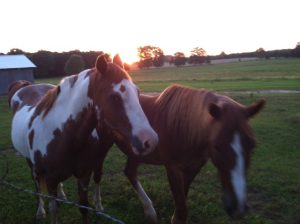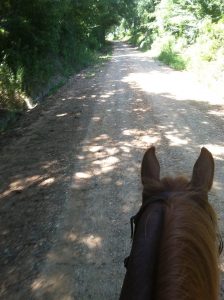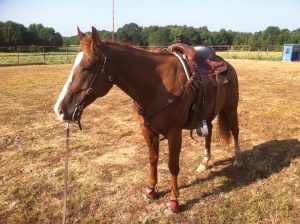I love reading. Few days go by that I don’t pick up one book or another for at least a few minutes of reading pleasure.
A few months ago, I wrote a post titled The Bibliophile specifically about my family’s love for books. I have learned many things through reading books, and books are a big part of who I am.
So, when I decided to start pursuing horsemanship, I turned to books. I discovered and read several books by several different authors. All were good and I learned from all of them. I also discovered a treasure trove of YouTube videos on the topic of horsemanship, which were also very helpful.
But you know what? Books and videos can only carry a would-be horseman so far. At some point, one must go out and spend time working with horses.
Many of the best horsemen refer to themselves as a student of the horse. In using this phrase they don’t just mean they study horses. Rather, they mean the horse is their instructor. If one would learn of horses, one needs to be instructed by a horse.
Ray Hunt is one of my favorite horsemanship authors. I’ve read his book, Think Harmony with Horses, five or six times across a two-year span, and with each reading I gain new insights.
In this book, Ray stated,
To digest [horsemanship] goals in the capsule form a person need only know ‘feel, timing, and balance.’
Clearly, in Ray’s estimation, this was an extremely important concept. However, he went on to say:
But the truth of the matter is that just those three small terms take a lifetime of chewing before they begin to digest. Though I will use them often, I will not attempt to provide the reader with a concrete description of any of them, for to me they are as abstract and elusive as the candle in the tunnel. What “feel” can be to a 4-H child today, with more chewing, each day it will be different. The same is true of a more advanced rider. As the rider grows in awareness and insight, so will the definition of these terms. Each person, in the final analysis, will write his or her own definition day by day. Although I cannot give you “feel,” I hope to fix it up to help the reader, or rider, find his own definition.
Basically, within his book written for the purpose of teaching horsemanship, Ray Hunt confessed the most fundamental part cannot be learned from a book. It must be learned experientially from a horse.
Accordingly, after reading Ray’s book, I spent time working with my horse. Then I came back and read the book again…and learned it made more sense than in the first reading. The same has been true of each subsequent reading.
Although I can learn a lot about horses by reading books, I can only come to know a horse by spending time with a horse. I have to learn to listen to my horse.
I can learn a lot about horses by reading books. I can only come to know a horse by spending time with a horse. Click To TweetThe same is true of most things in life. We can learn a lot from other people’s experiences shared in books, videos, or verbal communication. Such book learning can start us on the right path and continue to guide us as we work thru real-life issues. Ultimately, though, we only truly learn by doing.
Book learning can only take one so far. To really learn, one must do.
Book learning can only take one so far. To really learn, one must do. Click To TweetThis is not a difficult concept, and I think most people would readily agree.
So, why do so many people seem to expect something different of the Bible?
Like most Christians, I have a deep reverence for the Bible as God’s word…God’s revelation of Himself, written by men through the inspiration of the Holy Spirit.
I am sometimes surprised, however, at how many Christians seem to believe the Bible is the end of God’s revealing of Himself and His will to us. These Christians seem to live with no expectation of God ever communicating with us as individuals. They seem to expect prayer to be strictly a monologue and are suspicious of anyone saying God spoke to them about anything.
More concerning, these Christians seem to have no confidence whatsoever in the power of the Holy Spirit to give discernment and wisdom to God’s individual children in regard to specific situations in their personal lives. They seem to live their lives as though Christ’s admonition, “My sheep hear my voice” was not relevant to us, today.
As a result, they tend to turn to the Bible in search of definitive direction for every life circumstance. They tend to build legalistic doctrines filled with intricate rules and exception clauses (falsely) believed appropriate for application to all of life’s circumstances.
These folks tend to be very dogmatic in stating their beliefs…very closed to other people’s perceptions…very insistent that their view is the only legitimate view and anyone with a differing view is in error. They have a tendency to pluck support for their doctrines out of context…expecting to find answers to questions that are not addressed in their referenced passages.
These folks treat the Bible as though it were an owner’s manual for how to live life, rather than a revelation intended to lead us into intimate relationship with our Creator. They attempt to use the Bible as though it were a series of flow-charts with clear predefined decision-making logic intended to cover every circumstance in the human experience, rather than a book of revelation leading us to wrestle with heart-rending decisions in sometimes horrific circumstances while clinging tenaciously to faith in the goodness and faithfulness of an invisible God.
Why? Why do the beliefs and expectations of these fellow believers differ so drastically from my own?
They put their faith in book learning. I put my faith in the One who inspired the book.
I don’t expect the Bible to be a guide in all of life’s circumstances. I expect the Bible to guide me into intimate relationship with the Holy Spirit who leads me in all of life’s circumstances.
Just as in horsemanship, the most fundamental part cannot be learned from a book. It must be learned experientially from the Holy Spirit.
I can learn a lot about God by reading the Bible. I can only come to know God by spending time with Him…by talking with Him and listening to Him…by learning to trust Him and follow Him.
I can learn a lot about God by reading the Bible. I can only come to know God by spending time with Him Click To TweetYou search the Scriptures because you think that in them you have eternal life; it is these that testify about Me; and you are unwilling to come to Me so that you may have life. (John 5:39-40)
Scripture is only life-giving to the extent that it leads us to the Giver of Life.
Scripture is only life-giving to the extent that it leads us to the Giver of Life. Click To TweetYour thoughts?

 The young horses tend to gather at the northeast corner of the pasture each afternoon. There, they tease each other, chase each other, and just generally enjoy each other’s fellowship.
The young horses tend to gather at the northeast corner of the pasture each afternoon. There, they tease each other, chase each other, and just generally enjoy each other’s fellowship.

 I’m not an expert horse trainer. I am, at best, a novice horseman…maybe more of a wannabe horseman…which is okay, too. My only horse experience has been working with our own horses. So, take my observations with a grain of salt…I have a fairly narrow experience spectrum in regard to horse behavior.
I’m not an expert horse trainer. I am, at best, a novice horseman…maybe more of a wannabe horseman…which is okay, too. My only horse experience has been working with our own horses. So, take my observations with a grain of salt…I have a fairly narrow experience spectrum in regard to horse behavior. Halter in hand, I walk through the pasture gate and approach my horse. He looks up from grazing, facing me, expectantly. As I approach, I walk toward his shoulder rather than his face…horses sometimes seem intimidated by a direct face-to-face approach…and I want my approach to be welcomed. They’re prey animals…programmed by the Creator to be sensitive to such things.
Halter in hand, I walk through the pasture gate and approach my horse. He looks up from grazing, facing me, expectantly. As I approach, I walk toward his shoulder rather than his face…horses sometimes seem intimidated by a direct face-to-face approach…and I want my approach to be welcomed. They’re prey animals…programmed by the Creator to be sensitive to such things.
